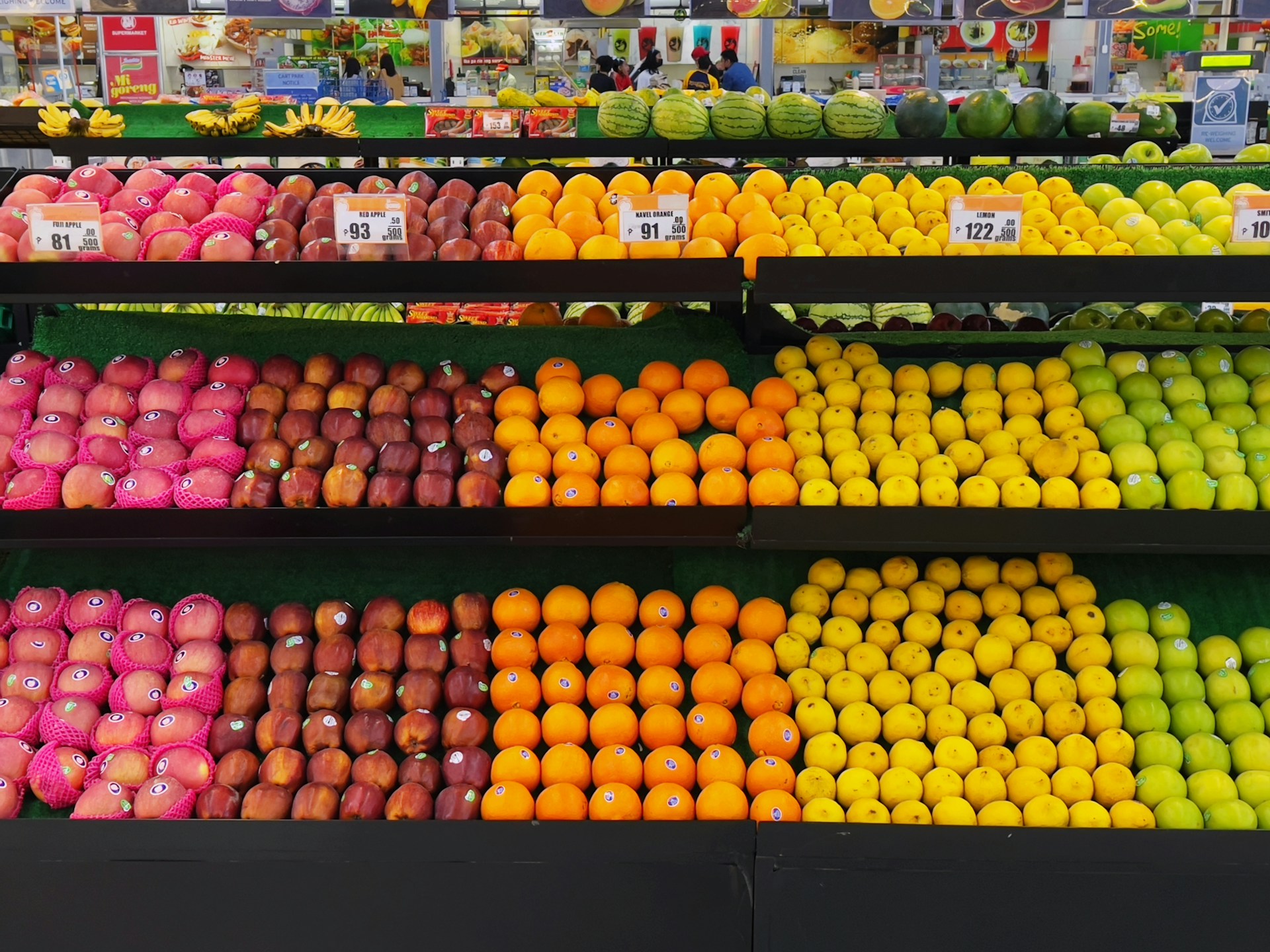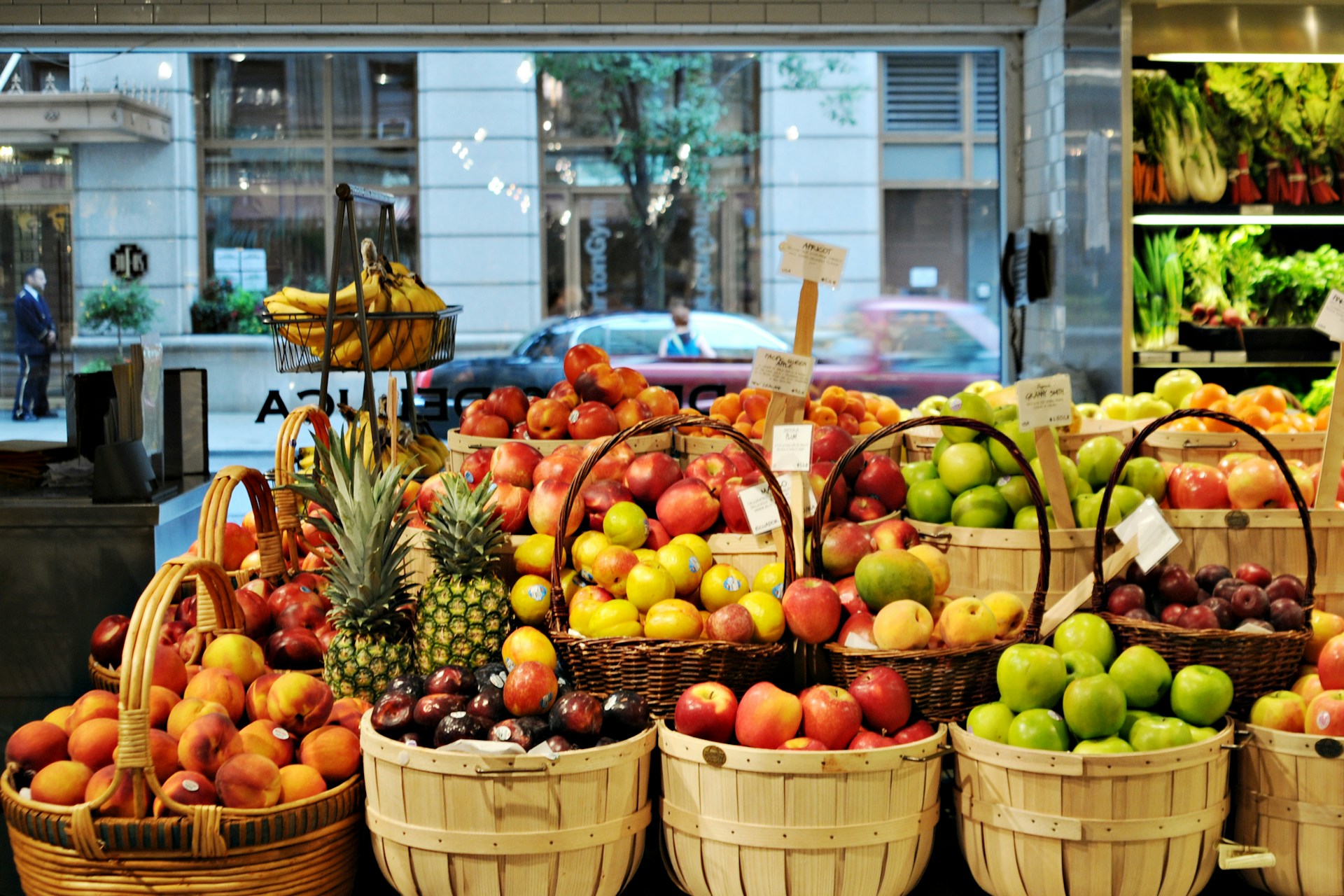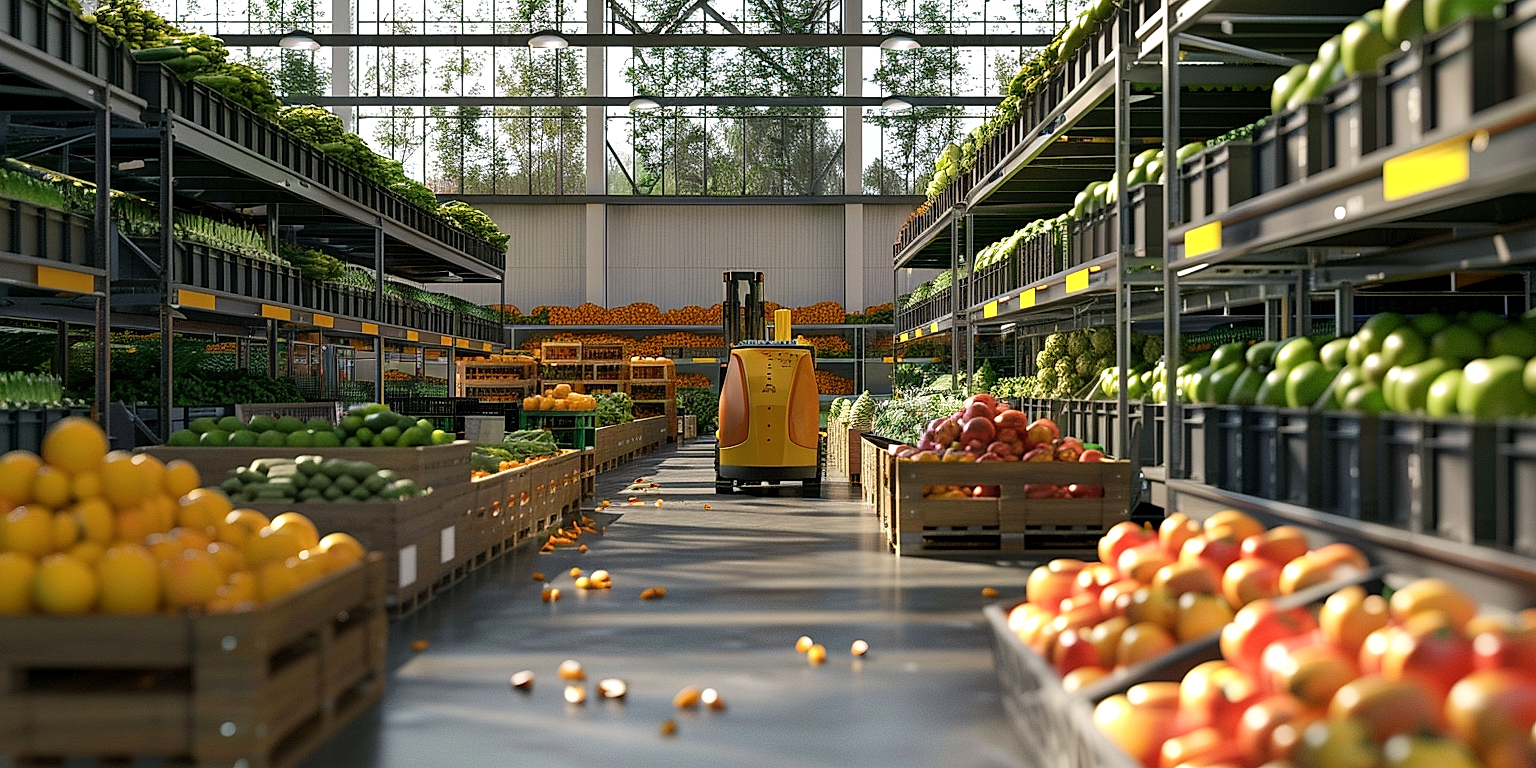Among the plethora of emergent technologies, few stand to revolutionize industries as profoundly as those related to logistics.
Advancements in this field are creating dynamic shifts in the produce distribution sector.
Quicker, safer, and more efficient systems of product movement are not only a dream but a tangible reality.
Changes are being experienced at all stages, from harvest to supermarket shelves.
In this article, we will delve deep into the most pivotal advancements in logistics technology and their implications for produce distribution.
Specifically, we’ll address how these innovations benefit both businesses and consumers, and what to anticipate for the future of grocery logistics.
Logistics Technologies Shaping Produce Distribution
1. Internet of Things in (IoT) in Cold Chain Management
The Internet of Things (IoT) is revolutionizing numerous sectors, and the logistics industry is no exception.
One crucial area where IoT is being heavily integrated is in cold chain management.
By its nature, cold chain management is incredibly complex, mainly because it involves the handling and transport of temperature-sensitive goods.
The introduction of IoT technologies in cold chain management has proven to be transformative, enhancing efficiency while ensuring product quality and safety.
IoT devices, such as sensors and trackers, provide real-time temperature and humidity monitoring, ensuring that perishable goods are stored and transported within the ideal conditions.
These devices play a significant role in reducing costly wastage that often results from improper temperature control.
Besides, they reduce the risk of spoiling perishable goods, which can have serious health implications for the consumers.
Moreover, IoT devices promote transparency and accountability in the cold chain process.
Data generated from these devices can be shared across all parties involved, including suppliers, logistics companies, and retailers.
This shared data enables various stakeholders to track the conditions of the goods at any given point in the supply chain, therefore, encouraging responsibility and integrity in handling perishable products.
Further, IoT facilitates smart decision-making in cold chain management.
Through predictive analysis based on data collected, stakeholders can make informed decisions to optimize the workflow, reduce costs, and improve service to customers.
For example, IoT devices could signal a cooling system to adjust the temperature based on real-time data.
This automated decision-making could significantly reduce human error and reaction time, leading to more efficient operations.
The widespread adoption of IoT in cold chain management is a clear indication of its enormous perceived benefits and potential it has to offer for the logistics industry especially in the distribution of fresh produce.
As IoT technologies continue to evolve, we can anticipate even more sophisticated solutions that will redefine cold chain management practices for the better.
2. Drone and Robotic Deliveries
The rise of drone and robotic technology is rapidly changing the landscape of produce distribution in the logistics industry.
These innovative technologies offer new possibilities for delivering fresh produce in a timely and efficient manner, reducing the traditional hurdles faced in physical delivery.
Drones are essentially unmanned aerial vehicles that can carry cargo over short to medium distances, while robots can handle the sorting, packaging, and even distribution tasks within a warehouse setting.
Being able to bypass congested roads and traffic, drones can quickly ferry small quantities of perishable produce directly from farm to market or restaurant, which significantly helps in maintaining freshness.
Drone and robotic technologies are not simply about speed, but they also enhance efficiency, cost-effectiveness and offer a more sustainable delivery solution.
Robots on the other hand, minimize errors in the sorting and packaging process, leading to increased accuracy and speed.
More so, they significantly reduce the need for human labor, thus driving down operational costs and allowing for scalability.
It’s also important to note that these technologies can operate round-the-clock, unlike human workers who require breaks and shifts.
The application of drone and robotic technologies is therefore crucial in creating a more effective and efficient cold chain system, ensuring that the quality of the produce is maintained from farm to the consumer.
However, there are regulatory and safety concerns that need to be addressed when fully implementing these technologies.
Concerns such as potential collisions with other flying objects for drones, or malfunctions leading to damages or injuries for robots must be taken into consideration, and regulatory bodies must step in to oversee their safe and standardized usage.
Despite these challenges, the potential benefits that drone and robotic technologies provide to produce distribution and the larger logistics industry cannot be ignored.
It is therefore imperative for industry leaders to actively explore these technologies, and pioneer their innovative application in the logistics industry.
By doing so, they not only enhance the efficiency and resilience of their supply chains, but also position themselves as future-ready businesses in a rapidly evolving industry.
Above all, the adoption and integration of drone and robotic technologies in produce distribution signals a forward-thinking approach in harnessing the power of technology to improve logistics efficiencies and maintain the freshness of our food supply in a more sustainable way.
3. Blockchain for Traceability and Transparency
The increasing need for transparency and traceability in the logistics and supply chain industry has led to the exploration and adoption of blockchain technology.
The core idea of blockchain is to provide a decentralized and immutable ledger, allowing for greater transparency and security.
When applied to the distribution of produce, blockchain could enhance tracing capabilities and ensure the quality and safety of products.
Blockchain’s inherent properties allow for a timestamped, unchangeable record of every transaction or movement associated with an entity, including produce.
Combining blockchain technology with existing logistics processes can provide a new level of traceability, from the farm right through to the end consumer.
This capability is particularly crucial in managing food safety incidents, recalls, counterfeiting, and fraud.
By recording critical data points such as the location, temperature, and time, every stakeholder in the supply chain can have full visibility into the journey of a product.
Moreover, the transparency achieved with blockchain technology can also boost consumer trust.
Customers today are demonstrating a strong desire to understand where their food comes from and how it’s handled, and a blockchain record can provide just that level of transparency.
Furthermore, blockchain’s capacity for smart contracts can automate processes, improving efficiency and reducing the scope for disputes or errors.
Despite its potential, the implementation of blockchain in logistics is not without challenges, such as integration with existing systems and the need for standardization and regulation of the technology.
Nevertheless, many industry leaders are already investing in and testing blockchain applications, signaling its growing acceptance and possible future mainstream adoption in the logistics industry.
Thus, the impact of blockchain on the logistics sector, particularly in the distribution of produce, cannot be overlooked.
With its promise of improved traceability and transparency, the technology has the potential to revolutionize the way produce is tracked and transported, opening up a myriad of possibilities for the future of the cold chain sector.
The gradual adoption and integration of blockchain technology in produce distribution are likely to lead to more flexible, reliable, and transparent supply chains, ultimately benefiting both businesses and consumers alike.
4. Autonomous Vehicles in Distribution
The adoption of autonomous vehicles in the logistics sector is a technological shift that is radically reshaping produce distribution.
These self-driving vehicles are designed to autonomously navigate roads, making them an innovative solution for reducing logistical inefficiencies and human errors in shipping.
Companies such as Tesla, Waymo, and others are investing heavily in the development of cutting-edge autonomous vehicle technologies, adding momentum to this logistical revolution.
The advantage of these vehicles lies in their capability to operate around the clock, minimizing delays in the supply chain and increasing productivity.
Moreover, autonomous vehicles can lead to significant cost reductions in the logistic operations by eliminating the expenses associated with drivers, such as wages, insurance, and training.
They can also increase safety in transport, as they are designed to avoid collisions, obey traffic rules, and adapt to various road conditions more effectively than human drivers.
Furthermore, integrating autonomous vehicles with other innovative solutions like IoT and AI technologies can optimize route planning and load arrangement, further improving the distribution process.
By collecting real-time data about a truck’s location and the status of its cargo, these technologies ensure greater transparency and traceability in the distribution process.
Still, the deployment of such vehicles in logistics isn’t without challenges. Legal and regulatory issues, along with major tech hurdles, must be addressed before these vehicles can be widely adopted.
For instance, in some regions, there are restrictions on the number of hours a self-driving truck can operate without human intervention, thus limiting their potential benefits.
There’s also the concern about job displacement, as autonomous vehicles could potentially replace human drivers, leading to significant social and economic implications.
Despite these concerns, the benefits of these vehicles make them a highly promising logistic solution. They are certainly set to play a prominent role in the advent of smart farming, where automation is key.
While autonomous vehicles have made significant progress, it’s crucial to remember that this technology is still in its nascent stage. As such, it’s going to take some time before it significantly impacts produce distribution.
As we continue to witness advancements in autonomous vehicle technologies, it’s clear that they are going to be a vital element of the future logistics landscape.
5. AI and Machine Learning for Demand Forecasting
In the realm of logistics technologies impacting produce distribution, Artificial Intelligence (AI) and Machine Learning (ML) stand out for their transformative potential.
These advanced computational tools are particularly effective in demand forecasting, a crucial aspect of supply chain and logistics management.
Accurate forecasting of demand enables more responsive and effective inventory management, helping reduce waste, saving costs, and ultimately driving operational efficiencies.
The use of AI and ML for demand forecasting is catalyzing a notable shift in the way the logistics industry operates.
AI algorithms analyze vast datasets from various sources like sales history, market trends, weather patterns, and even social and economic indicators to predict customer demand with impressive precision.
Such broad data sets would be overwhelmingly complex and time-consuming to analyze manually, but thanks to ML, which is inherently capable of learning from data, it can make predictive models that continually improve over time.
Moreover, the AI and ML systems can automatically adjust their algorithms based on the latest data and trends, making them much more responsive to market changes than traditional forecasting methods.
This adaptability is invaluable in an industry like produce distribution, where products are perishable and the margin for error is minimal.
Next-level forecasting through AI and ML not only helps predict demand with more accuracy but also assists in calculating the optimal pricing, automating order fulfillment, and even personalizing marketing initiatives.
This approach can provide a significant competitive advantage in a rapidly evolving market.
However, successful implementation of AI and ML requires a sound data strategy, as well as a workforce equipped with the necessary skills to harness the technology effectively.
One of the main challenges companies may face is ensuring the quality and reliability of the data used for machine learning algorithms.
Data privacy is another key concern that companies must navigate carefully when utilizing AI and ML for demand forecasting.
Overcoming these challenges is not an easy task, but the potential benefits far outweigh the complications, making AI and Machine Learning an integral part of the future of produce distribution.
As these technologies continue to advance, they promise to reshaping logistics operations in ways we can only begin to imagine.
6. Advanced Packaging Technologies
The role of Advanced Packaging Technologies cannot be overlooked when talking about logistics technologies shaping produce distribution.
These technologies are constantly evolving and innovating to ensure the safe and efficient transportation of goods, especially perishables like produce.
They offer smart and sustainable solutions that maintain the quality and extend the shelf life of fresh produce from farm to fork.
One of the leading technologies in this space is the use of Modified Atmosphere Packaging (MAP), which alters the atmosphere within the packaging to slow down the degradation process and maintain the freshness of the produce.
Advanced packaging solutions ensure the integrity and quality of produce, contributing significantly to reducing food waste.
Another promising packaging technology is the use of nanotechnology in food packaging, which can improve food safety by detecting harmful bacteria and extending the shelf life of the products.
The innovation of active and intelligent packaging solutions like time-temperature indicators, freshness indicators, and antimicrobial packaging helps in monitoring and maintaining the quality of the produce throughout the cold chain.
These technologies provide real-time information about the temperature, humidity and other environmental conditions the produce has been subjected to during transportation.
Moreover, the use of recyclable and biodegradable materials in packaging is gaining traction, supporting sustainability goals while also providing efficient solutions for produce distribution.
For instance, the development of edible packaging materials made from food by-products can offer a zero-waste solution for the packaging of fresh produce.
Even more, smart labeling technologies are being incorporated into packaging solutions to provide detailed traceability and authenticity of the produce.
These labels can provide comprehensive information from the origin of the produce to its entire journey in the supply chain, thereby improving transparency and gaining consumer trust.
All these advancements in packaging technologies directly contribute to the efficiency of logistics and distribution in the produce industry.
However, the integration of these technologies into existing processes requires significant investment, infrastructure, and strategic planning.
Despite the challenges, the benefits of these advanced packaging technologies, such as increased shelf life, reduced food waste, improved food safety, and enhanced traceability, make them fundamental to the future of produce distribution.
7. Augmented Reality for Warehouse Management
As the world of logistics continues to evolve at a dizzying pace, augmented reality (AR) is rapidly emerging as a crucial technology for warehouse management.
In the fiercely competitive field of produce distribution, utilizing AR can be a game-changer. It can dramatically increase efficiency, reduce errors, and ultimately lead to significant cost savings.
The integration of AR into warehouse management is being propelled by the escalation of e-commerce and the growing consumer demand for instant gratification, encouraging businesses to ensure faster, smoother and more accurate deliveries.
AR technology enhances warehouse operations by providing staff with real-time visual guidance on how and where to store, pick, and move items.
This capability allows for quicker decision-making, reduces the chance of mistakes, and increases safety by showing workers potential obstacles in their path.
Moreover, AR can also offer comprehensive training to new warehouse employees, providing interactive and immersive learning experiences, which can increase the speed of training and improve retention of information.
AR glasses, a common form of this technology used in warehouses, allows employees to have hands-free access to relevant information without the need to look down at a handheld device. This can significantly increase employee productivity.
In the realm of inventory management, AR technology can be used to easily identify and locate items in a large warehouse, minimizing time spent on searching for products.
Moreover, AR can also identify damaged goods and automatically update stock levels, placing a reorder if necessary, contributing to autonomous inventory management.
Furthermore, AR has the potential to optimize the layout of a warehouse by visualizing data about item popularity, picking paths, and storage locations. This can potentially lead to a dramatic reduction in walking time for employees and increase overall efficiency.
AR can also be combined with other advanced technologies, such as Internet of Things (IoT) devices and artificial intelligence (AI), to create a connected, intelligent warehouse.
For example, AR glasses can receive information from IoT sensors to detect temperature changes, potentially preventing spoilage in a produce warehouse, or use AI to predict future demand and suggest optimal stock levels.
While there are challenges in the implementation of AR, such as initial cost, technology maturity, and workforce acceptance; the foreseeable enhancements in productivity, accuracy, and efficiency make a compelling case for the adoption of AR in warehouse management.
Therefore, adopting augmented reality in warehouse management could be a major step towards building a more agile and competitive distribution operation in the logistics industry.
The Bottom Line
With the rapid advancements in technology, several trends are shaping the future of logistics and supply chain management.
The adoption of the Internet of Things (IoT) has significantly enhanced cold chain management, ensuring better tracking and quality control of perishable goods through real-time monitoring.
Innovations such as drone and robotic deliveries are accelerating package delivery while reducing human error.
The application of blockchain technology promises enhanced traceability and transparency, ensuring greater security and trust in the supply chain.
Autonomous vehicles are poised to revolutionize distribution, providing efficient and cost-effective solutions.
The integration of AI and Machine Learning enables accurate demand forecasting, promoting efficiency and reducing waste.
Other major developments include advanced packaging technologies for safety and sustainability and the use of augmented reality in warehouse management to optimize operations.
These trends are set to redefine the industry by maximizing efficiency, accuracy, and sustainability.




